The 1954 Austin-Healey 100-4, a British icon, emerged as a pivotal moment in the evolution of sports cars. This sleek, powerful machine, born from a collaboration between the Austin Motor Company and Donald Healey Motor Company, captivated the world with its blend of performance and elegance.
The 100-4, as it was affectionately known, embodied the spirit of post-war Britain, a nation eager to embrace speed and style. Its arrival marked a departure from the more conservative automotive designs of the era, setting a new standard for performance and driving experience.
The 100-4’s design, a testament to the era’s burgeoning fascination with aerodynamic principles, featured a low-slung body, a powerful engine, and a lightweight chassis. Its performance statistics were equally impressive, boasting a top speed of over 100 miles per hour, a feat rarely achieved by cars of its time.
This combination of speed, style, and affordability made the 100-4 an instant success, attracting both seasoned drivers and those seeking a taste of the thrilling world of sports car ownership.
The Austin-Healey 100-4: A British Icon
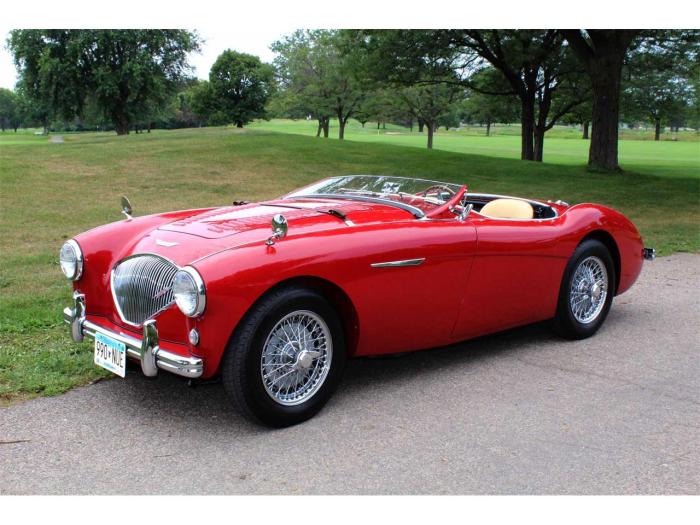
The 1954 Austin-Healey 100-4 was a revolutionary sports car that marked a pivotal moment in British automotive history. This model, a collaboration between the Austin Motor Company and the Donald Healey Motor Company, brought together performance, style, and affordability in a way that captivated enthusiasts worldwide.
The 100-4’s success was fueled by a combination of innovative design elements and a strategic approach to its target market. Its sleek, aerodynamic bodywork, crafted by designer Gerry Coker, was a departure from the boxy sports cars of the time.
The car’s performance was equally impressive, powered by a 2.6-liter inline four-cylinder engine that delivered 100 horsepower, a remarkable figure for the era. This engine, mated to a four-speed manual transmission, propelled the 100-4 to a top speed of 107 mph, making it one of the fastest production cars of its time.
Target Market and Historical Context
The Austin-Healey 100-4 was launched in a post-war world where the demand for affordable and exciting sports cars was growing. The car’s target audience was young, affluent, and eager to embrace the spirit of freedom and adventure that the 100-4 embodied.
It was marketed as a car for both weekend driving and competitive motorsports, appealing to both recreational and serious drivers.The 100-4’s launch coincided with the burgeoning popularity of sports car racing, particularly in the United Kingdom. The car’s competitive edge was quickly established, with its first major victory coming at the 1954 Le Mans 24 Hours race.
The 1954 Austin-Healey 100-4, a true icon of the golden age of British sports cars, was known for its sleek design and powerful engine. While it was a formidable machine, its successor, the 1962 Austin-Healey Sprite , took a different approach, offering a more affordable and nimble experience.
The Sprite, with its compact size and lightweight construction, became a popular choice for enthusiasts seeking a fun and agile driving experience. The 100-4, with its timeless appeal and enduring legacy, remains a sought-after classic.
This success further cemented the 100-4’s reputation as a formidable performer and a symbol of British engineering excellence.
Design and Engineering
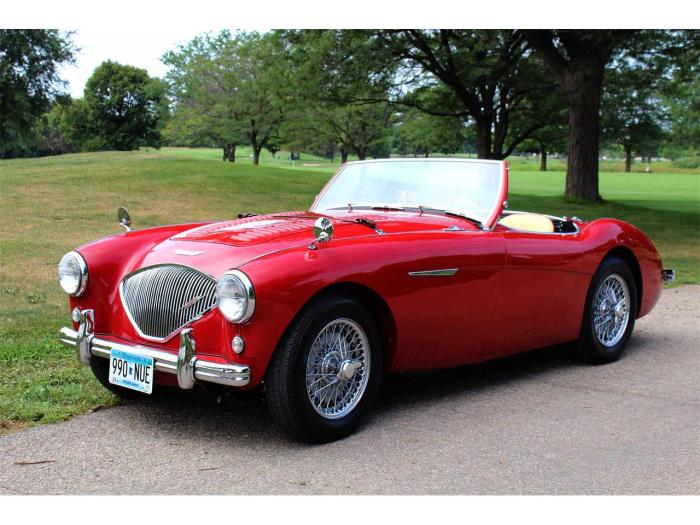
The 1954 Austin-Healey 100-4 was a groundbreaking sports car that embodied a harmonious blend of performance and aesthetics. Its design philosophy was driven by the desire to create a car that was both fast and beautiful, capable of thrilling drivers on the road and on the racetrack.
Design Philosophy
The 100-4’s design philosophy was deeply rooted in the principles of lightweight construction, aerodynamic efficiency, and elegant styling. The car’s low-slung body, with its distinctive long bonnet and short tail, was designed to minimize drag and maximize speed. The use of lightweight materials, such as aluminum for the body panels and a tubular steel chassis, contributed to the car’s exceptional power-to-weight ratio.
The 100-4’s design was a testament to the British tradition of building elegant and powerful sports cars, with a focus on both form and function.
Materials and Construction
The Austin-Healey 100-4 was constructed using a combination of materials and techniques that were both innovative and traditional. The car’s chassis was made of a lightweight tubular steel frame, which was designed to provide both strength and rigidity. The body panels were crafted from aluminum, which was chosen for its lightness and resistance to corrosion.
The car’s interior was finished with high-quality leather and wood, reflecting the attention to detail that was characteristic of British craftsmanship.
Engineering Innovations
The 100-4’s engineering innovations were key to its performance capabilities. The car was powered by a 2.6-liter inline four-cylinder engine, which was derived from the Austin A90 Atlantic. The engine was equipped with twin SU carburetors and a high-lift camshaft, which allowed it to produce a respectable 100 horsepower.
The car’s suspension system was designed for both comfort and handling, featuring independent front suspension with coil springs and a live rear axle with leaf springs. The 100-4’s four-wheel disc brakes were a significant innovation for the time, providing superior stopping power compared to drum brakes.
Performance and Handling
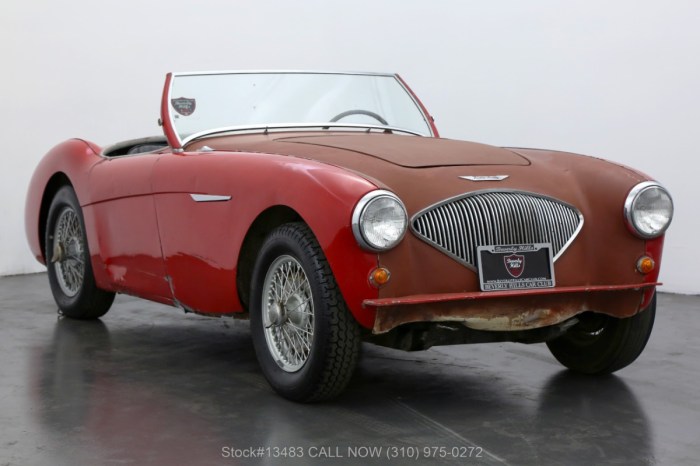
The Austin-Healey 100-4, despite its relatively modest engine size, was a true performance car for its time. Its lightweight design and powerful engine allowed it to achieve impressive speed and handling, making it a formidable competitor on both the road and the track.
Performance Statistics
The 1954 Austin-Healey 100-4 was powered by a 2.6-liter four-cylinder engine that produced 90 horsepower. This allowed the car to reach a top speed of around 100 mph, which was remarkable for a production car of its era. The 100-4 could accelerate from 0 to 60 mph in about 12 seconds, making it one of the fastest cars on the market.
The car’s braking performance was also noteworthy, with the drum brakes providing adequate stopping power for its time.
Handling Characteristics
The Austin-Healey 100-4 was known for its agile and responsive handling. Its lightweight construction and independent front suspension allowed it to corner with precision and stability. The car’s low center of gravity also contributed to its exceptional handling, making it a joy to drive on winding roads.
Comparison with Other Sports Cars
The Austin-Healey 100-4 was a formidable competitor in the sports car market of the early 1950s. It offered a compelling combination of performance, handling, and affordability, making it a popular choice for enthusiasts. While cars like the Jaguar XK120 and the MG TD offered similar performance, the 100-4 was generally considered to be a more well-rounded and versatile sports car.
Its combination of speed, handling, and practicality made it a true icon of its time.
Legacy and Impact
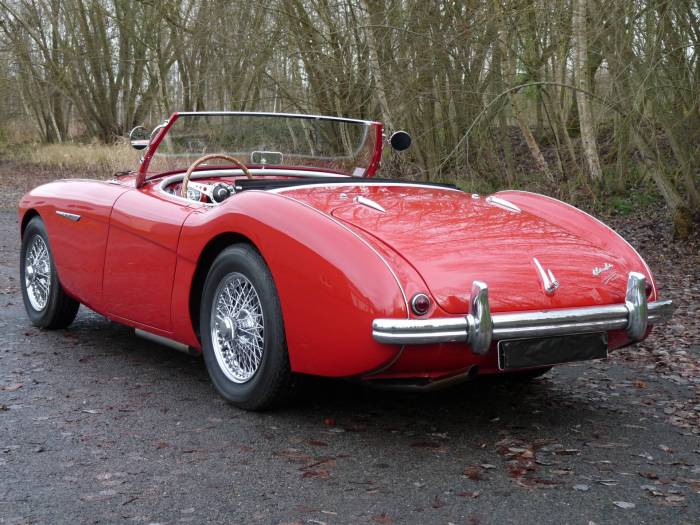
The 1954 Austin-Healey 100-4, a pioneering sports car that redefined British automotive excellence, left an indelible mark on the automotive landscape. Its influence transcended mere design aesthetics, shaping the evolution of sports cars and igniting a passion for performance driving that continues to this day.The 100-4’s impact on the automotive industry is multifaceted.
It established a benchmark for performance and handling, inspiring subsequent sports car designs. The model’s sleek lines, lightweight construction, and powerful engine became hallmarks of the burgeoning sports car segment. The 100-4’s success paved the way for a new generation of British sports cars, including the iconic MG and Triumph models, which went on to achieve global acclaim.
Popularity and Motorsports
The 100-4’s popularity extended beyond its aesthetic appeal. It quickly gained a reputation as a capable and exhilarating performer on both the road and the racetrack. Its competitive spirit was evident in its participation in numerous motorsports events, including the prestigious 24 Hours of Le Mans.
The 100-4’s success in motorsport further solidified its status as a true sports car icon.
The 1954 Austin-Healey 100-4, with its iconic lines and powerful engine, was a British sports car that captured the hearts of enthusiasts. The following year, 1955, saw a significant update with the 1955 Austin-Healey 100-4 , which included refinements to the suspension and a larger fuel tank.
This model cemented the Austin-Healey’s reputation as a capable and stylish road racer, a legacy that continues to inspire collectors today.
Enduring Appeal
The 1954 Austin-Healey 100-4’s enduring appeal can be attributed to a confluence of factors:
- Performance and Handling: The 100-4’s lightweight design, powerful engine, and responsive handling made it a joy to drive. Its ability to deliver exhilarating performance on both winding roads and racetracks cemented its reputation as a true sports car.
- Style and Design: The 100-4’s sleek and elegant design, characterized by its flowing lines and distinctive grille, captured the spirit of the era. Its timeless aesthetics continue to captivate automotive enthusiasts today.
- Heritage and History: The 100-4’s association with the legendary Austin-Healey brand, known for its innovative and performance-oriented cars, added to its prestige. Its rich history and iconic status have made it a highly sought-after collector’s item.
Notable Variations and Modifications
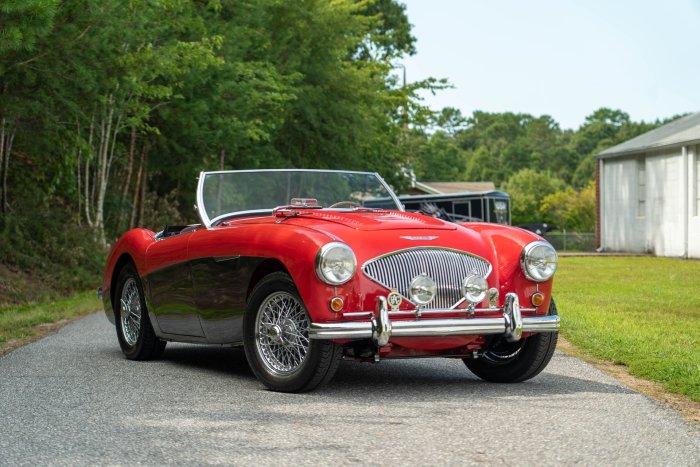
While the 1954 Austin-Healey 100-4 was a remarkable car in its standard form, its legacy was further enriched by a series of notable variations and modifications. These changes, driven by a combination of performance aspirations, market demands, and evolving regulations, resulted in a diverse range of 100-4 models, each with its own unique character and appeal.
The 100M and its Evolution
The 100M, introduced in 1955, represented a significant step forward in performance. This high-performance variant featured a number of upgrades, including a larger 2.6-liter engine, a revised suspension, and a more aerodynamic body. The 100M was capable of reaching speeds exceeding 100 mph, making it one of the fastest production cars of its time.
The 1954 Austin-Healey 100-4, with its distinctive flowing lines and powerful engine, was a landmark sports car that captured the spirit of the era. Its sibling, the 1954 Austin-Healey 100 BN1 , shared the same engine and chassis but featured a more refined bodywork, making it a popular choice among enthusiasts.
The 100-4’s legacy, however, remains strong, particularly for those who appreciate its raw performance and timeless design.
This model’s significance lies in its contribution to the Austin-Healey’s racing heritage, as it proved highly competitive in both road rallies and circuit racing.
The 100/6
In 1956, the 100-4 was replaced by the 100/6, which featured a larger and more powerful six-cylinder engine. This engine change marked a departure from the original four-cylinder design, offering greater power and torque. The 100/6 retained the classic Austin-Healey styling but offered a more refined driving experience.
This transition from four to six cylinders showcased the company’s commitment to continuous improvement and adaptation to market demands.
Factory Modifications and Options
The 100-4 was also offered with a variety of factory modifications and options. These included different engine tuning packages, upgraded suspension components, and a range of cosmetic enhancements. These modifications allowed owners to customize their cars to suit their individual preferences and driving styles.
These options, available directly from the factory, underscored the model’s versatility and its ability to cater to a diverse clientele, from everyday drivers to performance enthusiasts.
Post-Production Modifications
Beyond factory options, numerous aftermarket modifications were developed for the 100-4. These included high-performance engine upgrades, suspension tuning kits, and aerodynamic enhancements. Enthusiasts embraced these modifications to further enhance the car’s performance and handling capabilities. This aftermarket scene contributed significantly to the 100-4’s enduring appeal and its status as a platform for customization and performance enhancement.
Ownership and Restoration
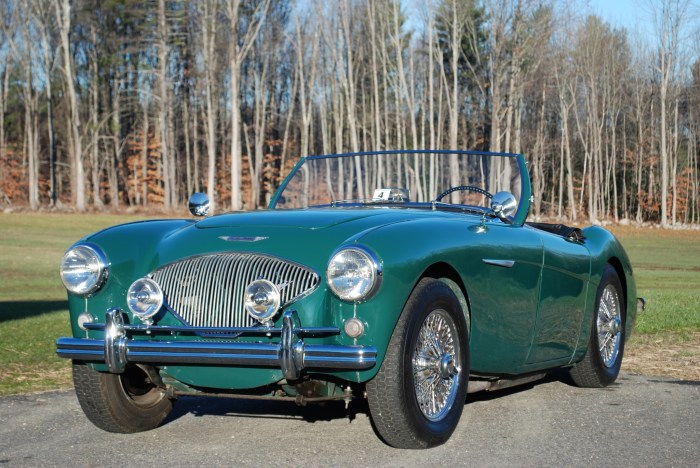
Owning and restoring a 1954 Austin-Healey 100-4 is a journey that blends passion, dedication, and technical expertise. While the car’s classic charm and performance appeal to many, the journey of ownership requires a deep understanding of the car’s history, market dynamics, and the intricacies of restoration.
Availability and Pricing
The 1954 Austin-Healey 100-4 is a sought-after classic, with its availability and pricing influenced by factors such as condition, restoration status, and market demand.
- Finding a 1954 Austin-Healey 100-4:The car’s popularity means that finding a suitable example can be a challenge. Online marketplaces, classic car auctions, and specialized dealerships are common avenues for finding these vehicles.
- Pricing:Prices for 1954 Austin-Healey 100-4s can vary significantly depending on condition. A well-restored example in excellent condition can command a price upwards of $100,000, while a project car in need of restoration could be found for a lower price, ranging from $20,000 to $50,000.
Restoration Options, 1954 Austin-Healey 100-4
Restoring a 1954 Austin-Healey 100-4 is a labor of love that requires specialized knowledge and resources.
- Professional Restoration:Hiring a professional restoration shop offers the benefit of expert craftsmanship and access to specialized parts and expertise. This option, however, can be expensive, with costs potentially reaching tens of thousands of dollars.
- DIY Restoration:For the mechanically inclined, restoring the car themselves can be a rewarding experience. However, it requires significant time, effort, and access to parts and resources. Online forums, enthusiast communities, and specialized parts suppliers can be invaluable resources for DIY restorations.
Resources and Communities
Owning a classic car like the 1954 Austin-Healey 100-4 fosters a sense of community among enthusiasts.
- Austin-Healey Clubs:The Austin-Healey Club of America (AHCA) and its regional chapters provide a platform for owners to connect, share knowledge, and participate in events.
- Online Forums:Websites like the Austin-Healey 100-4 Forum and other online communities offer valuable resources for owners, including technical advice, parts sourcing, and restoration tips.
- Parts Suppliers:Specialized suppliers like Moss Motors and British Motor Heritage provide a wide range of parts for the Austin-Healey 100-4, catering to both restoration and maintenance needs.
Challenges and Rewards
Owning a classic car like the 1954 Austin-Healey 100-4 comes with its own set of challenges and rewards.
- Maintenance:Maintaining a classic car requires specialized knowledge and access to parts. Regular servicing, preventative maintenance, and the potential for unexpected repairs are part of the ownership experience.
- Reliability:While the Austin-Healey 100-4 is a well-engineered car, its age and mechanical complexity can lead to occasional issues. Having a trusted mechanic and a well-stocked toolkit is essential.
- Driving Experience:The thrill of driving a classic sports car like the Austin-Healey 100-4 is a unique and rewarding experience. Its responsive handling, raw power, and open-air driving experience make every journey memorable.
Wrap-Up: 1954 Austin-Healey 100-4
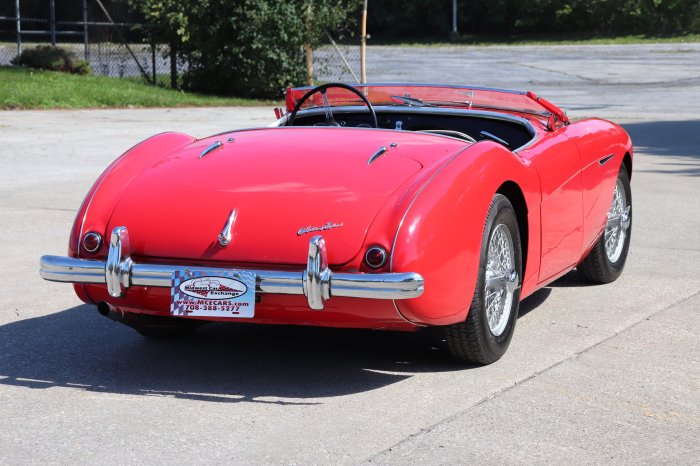
The 1954 Austin-Healey 100-4’s legacy extends far beyond its initial impact on the automotive landscape. Its influence can be seen in the design and engineering of countless sports cars that followed, solidifying its position as a true pioneer. Today, the 100-4 remains a cherished classic, sought after by collectors and enthusiasts worldwide.
Its enduring appeal lies not only in its historical significance but also in the visceral experience it offers, a reminder of a bygone era when driving was as much about passion as it was about transportation.